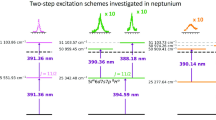Abstract
SILICON monosulphide is a member of a group of diatomic oxides, sulphides, selenides and tellurides of carbon, silicon, germanium, tin and lead which has formed the subject of some recent spectroscopic investigations1. Its rotational constants are therefore of interest for comparison with other molecules of this group, and also for comparison with P2, which possesses the same number of extra-nuclear electrons.
Similar content being viewed by others
References
Discussion on Band Spectra, Proc. Phys. Soc., 56, 204 (1944).
Barrow, R. F., and Jevons, W., Nature, 141, 833 (1938).
Barrow, R. F., and Jevons, W., Proc. Roy. Soc., A, 169, 45 (1938).
Saper, P. G., Phys. Rev., 42, 498 (1932).
Schomaker, V., and Stevenson, D. P., J. Amer. Chem. Soc., 63, 37 (1941).
Herzberg, G., "Molecular Spectra and Molecular Structure. I. Diatomic Molecules" (New York: Prentice-Hall, 1939.)
Kronig, R. de L., "Optical Basis of the Theory of Valency" (Cambridge, 1935).
Author information
Authors and Affiliations
Rights and permissions
About this article
Cite this article
BARROW, R. Rotational Analysis of Ultra-Violet Bands of Silicon Monosulphide. Nature 154, 364–365 (1944). https://doi.org/10.1038/154364b0
Issue Date:
DOI: https://doi.org/10.1038/154364b0
- Springer Nature Limited





